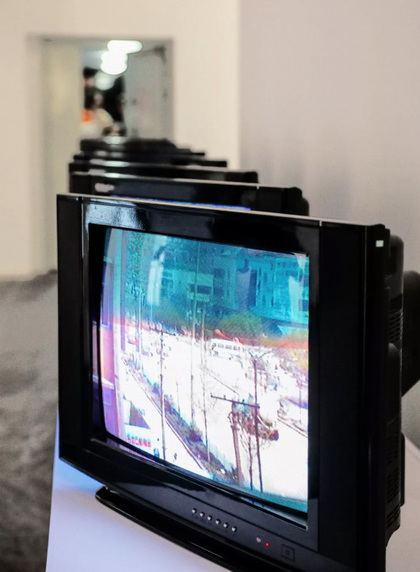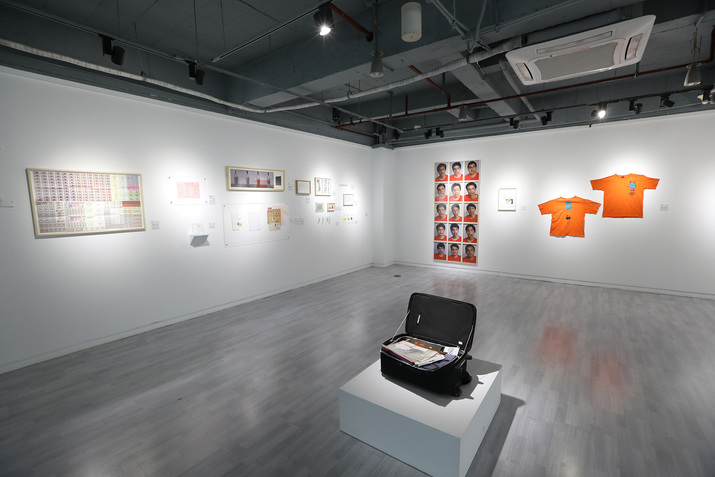-
From Current Issue
-
- Editor’s Letter Fire in the Heart
- Reviews I Gusti Ayu Kadek Murniasih
- Reviews 11th Seoul Mediacity Biennale: “One Escape at a Time”
- Dispatch Networked China
- One on One Monira Al Qadiri on Yukio Mishima
- Essays The rise of independent art spaces in pandemic-era Shanghai
- Features Tuan Andrew Nguyen
- Table of Contents
- Web Exclusives
- Archive
- Subscribe

R
E
V N
E
X
T
Installation view of “A Turning Moment: Urban Narratives in Chinese Contemporary Art, 1995–2019,” at the Shanghai Duolun Museum of Modern Art, 2019. All images courtesy the artists and Shanghai Duolun Museum of Modern Art.
A Turning Moment: Urban Narratives in Chinese Contemporary Art, 1995–2019
The Duolun Museum of Modern Art in Shanghai has had little in the way of programmed exhibitions in the past two years. Examining a period in which Chinese artists began to move art into social spaces and investigate the rapid alterations brought about by the 1978 Open Up and Reform Policy, “A Turning Moment: Urban Narratives in Chinese Contemporary Art, 1995–2019” represented a welcome return to the city’s art scene.
The date range for the exhibition felt somewhat arbitrary, beginning after the watershed marked by early reforms, as well as the social actions of featured artists such as Zhang Peili, who formed Pond Society with Geng Jianyi and Song Ling in 1986 explicitly to remove art from its narrow academic context and explore public interaction. Also missing are the actions of such social practitioners as Datong Dazhang, or reference to the 1989 “China/Avant Garde Exhibition.” These exclusions were explained during the press conference by the assertion that prior to the 1990s, urban art was political, whereas afterwards, it focused on more local, social concerns. One could easily read this shift in perspective as a result not of the changing ideals but of a change in rhetoric after the 1989 events in Tiananmen Square, and the high degree of control over public space across China since.
Nevertheless, “A Turning Moment” featured significant works evoking the disappearance of the familiar, beginning with Zhang Peili’s Focal Distance (1996), an early video of an ordinary Hangzhou intersection. The original footage was re-recorded seven times, causing the day-lit scene to degrade to shadowy abstraction. Zhang’s work isn’t easily situated within the context of social commentary, however, given his preoccupation with video as a medium, and his avoidance of didacticism. Zhuang Hui’s Longitude 109.88, Latitude 31.09 (1995–2008), featuring large-format photographs of holes drilled into the ground along the length of the valleys affected by the Three Gorges Dam, speaks more overtly to vanishing communities displaced by construction. Elsewhere, Song Dong’s photographs from the performance A Pot of Boiling Water (1995) portray the artist pouring water as he walks down an alley between Beijing’s iconic, fast-disappearing hutong houses. Images taken of the artist at close proximity reveal the water already evaporating into steam—a symbol of the site’s impermanence as Beijing’s old neighborhoods are steadily razed.
A particular highlight was the special presentation of “DIAL 62761232,” the much referenced but rarely seen archive of a roving exhibition project initiated in 2004 by Xu Zhen’s BizArt alternative space. Featuring 42 artists including Liu Wei, Ding Yi, and Yang Fudong, the mini exhibitions were transported in suitcases around Shanghai by specially trained couriers from a local delivery company, who would then explain the works to the recipient.
“A Turning Moment” also included several works that were spread out through the local neighborhood, such as Li Jinghu’s Ruins (2019), a steel cage that mirrored the form of a nearby Minguo-era building and contained parts of the structure discarded during renovation. To extend the boundary of the exhibition space tested the limits of regulated public space, in keeping with the concept of the show, while obviously observing local government requirements.
Installation view of LI JINGHU’s Ruins, 2019, installation, marble, granite, dimensions variable, at “A Turning Moment: Urban Narratives in Chinese Contemporary Art, 1995–2019,” Shanghai Duolun Museum of Modern Art, 2019.
There were some glaring omissions of younger artists, with few born after 1980. Li Binyuan, who had a solo exhibition across town at Ren Space, was notably absent, despite making performative work that pushes the boundaries of social practice. Ge Yulu, whose work focuses on the performance of personal behaviors in public spaces, as well as creative interventions such as replacing a Beijing street sign with one bearing his name (lu being Mandarin for “road”), would also have been a relevant addition.
“A Turning Moment” had the feeling of an academic exhibition in need of a good budget and a more spacious venue to fulfill its ambitions. One hopes that curator Azure Wu continues her research into this important area of recent Chinese social art practice.
“A Turning Moment: Urban Narratives in Chinese Contemporary Art, 1995–2019” is on view at the Shanghai Duolun Museum of Modern Art until December 15, 2019.
To read more of ArtAsiaPacific’s articles, visit our Digital Library.

















